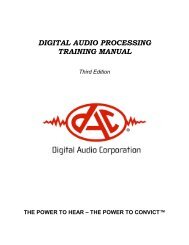QuickEnhance® VST User's Manual - Digital Audio Corporation
QuickEnhance® VST User's Manual - Digital Audio Corporation
QuickEnhance® VST User's Manual - Digital Audio Corporation
Create successful ePaper yourself
Turn your PDF publications into a flip-book with our unique Google optimized e-Paper software.
5.3 SPEECH<br />
What a nice conversation to listen to!<br />
For the purpose of this primer, we are going to concentrate on trying to<br />
reduce noise to hear the speech. In some applications, there may be<br />
other compelling reasons to analyze the entire audio signal, but for our<br />
purposes we will just try to make the voices more intelligible. We are<br />
interested not in analyzing the voice but only in determining what is<br />
said.<br />
The human voice communicates an abundance of information of which<br />
words are but a small part. The speaker’s sex and age, emotional state,<br />
level of education, dialectical influences, and physical attributes are all<br />
communicated in the acoustic waveform. In order to preserve all of this<br />
information, the voice should be recorded and processed with as much<br />
fidelity as possible.<br />
Now remember, we said that many people can hear audio signals up to<br />
20,000 Hz. That’s quite a range, but for our purposes much of that<br />
frequency range consists primarily of noise. Pay attention here: the<br />
most important speech information is located between 200 and 5000 Hz!<br />
In most cases, audio signals outside this range will be considered<br />
“noise” according to our definition. Sometimes a voice will have<br />
frequency characteristics outside this range (low or high) so it may be<br />
necessary to adjust our processing frequency band. Remember these<br />
numbers, as they will continually come into play when we begin our<br />
process of reducing background noise. So as a rule of thumb, we can<br />
establish the voice frequency range as 200 – 5000 Hz.<br />
Vowels typically have high energy concentrated below 3000 Hz.<br />
Consonants, on the other hand, have lower energy and typically are<br />
distributed both below and above 3000 Hz. Both are very important for<br />
word discrimination. Speech is also classified as a semi-random audio<br />
signal because its components are relatively unpredictable. The figure<br />
below shows the average spectrum of many people’s voices.<br />
17
















